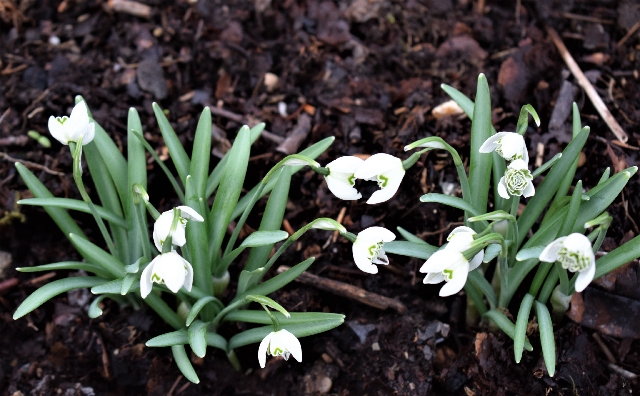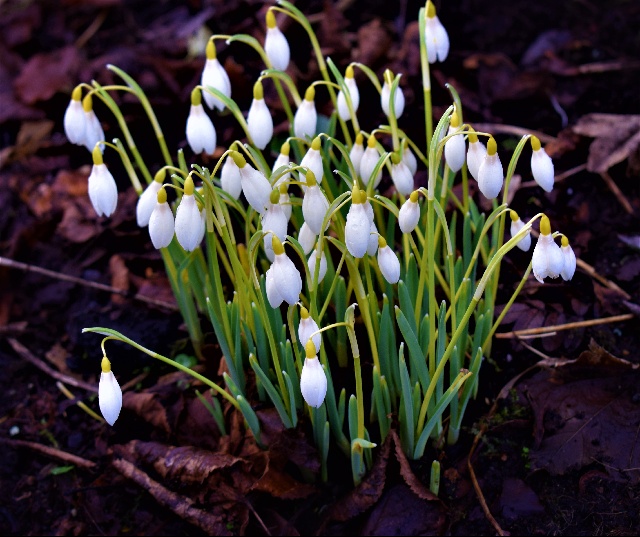Authors: L.
Leaves flat, glaucous, 5-21cm by 4-9mm. Outer tepals 1.2-3.5cm by 4-11mm, inner tepals with apical green inverted horse-shoe markings which seem to be constant, not flared at the apex, 6-12mm by 4-7mm Western Europe to Switzerland and the Caucasus. Widely naturalised in England, Wales and Scotland, sometimes considered native. Sets seed in seasons warm enough for early honey bee activity. 'April Fool', is a selection which can still be in flower on April 1st. It has a very thin and small inverted horse-shoe shape mark. Found in the 1960s by Tony Venison of Hertfordshire. Other clones flower in April, two of which have hybridised with G. plicatus. Var. angustifolius is smaller in all its parts with relatively narrow leaves and has been in cultivation since the mid 1950s. 'Bitton' almost certainly originated from Canon Ellacombe's garden at Bitton, Gloucestershire, distributed in the 1960s by the Giant Snowdrop Co. Very early flowering, following G. 'Atkinsii', with a yellow ovary similar to forms of G. gracilis. Much larger than normal G. nivalis with either leaf margin explicative. Probably a hybrid with G. plicatus and not previously described. 'Boyd's Double' (syn. Boyd's Green Double, Double Green, or Green Horror). William Boyd in 1905 said this occurred in Miss Russell's garden at Ashiestiel near Melrose, Berwickshire and gave an extremely good description but no name. It was probably first validly described in The Daffodd and Tulip Year Book 1971 R.H.S. by Richard Nutt. The flower very variable, but described as being erect, the outer tepals can be four and slightly larger than the inner of which there are about twenty. Both outer and inner tepals are extremely narrow, about 2.5mm (outer) to 1.4mm (inner). There is a long green marking on the outer and inner faces of the outer tepals, while the outer faces of the inner tepals are similar with a diminutive inverted horseshoe shaped mark. Some years it looks different but equally odd. Boyd found it grew well on clay. It is
very rare, late flowering and as difficult to grow as it is ugly. Subsp. cilicicus has glaucous, sprawling flat leaves longer than those of G. nivalis especially at flowering time. It is native to Turkey north to Mersin and eastwards in limestone rock fissures north-facing, blooming early to mid winter. Courteenhall, was found by Oliver Wyatt in the late 1960s amongst a vast number of G. nivalis at Courteenhall near Northampton. Similar to Viridapice, the outer tepals long and thin with a very extended claw bearing broad green fused lines near the apex. ('Viridapice' has separate green lines). Outer face of inner tepals with a long green mark from one third to one half, the green extending inside the margin like the upper half of the arms of an H-shaped mark. Rare in cultivation but desirable. 'Dwarf Form' is a less tall form of G. nivalis, possibly the same as 'Tiny'. 'Flavescens', see 'Sandersii'. Flore-pleno has fully double flowers, usually a little later than G. nivalis. There are distinct variants of it but not easy to describe. 'Four Petals' or 'Four Segments', a variant which appears from time to time in gardens with four outer tepals, but they do not seem to persist. 'Green Tip' has outer tepals with green lines towards the tips. Has been found on numerous occasions in Great Britain and may or may not be constant. It does not seem to be in cultivation at present. 'Flore-Pleno Hambutt's Orchard', was found by the owner of the Giant Snowdrop Co in a garden called Hambutt's Orchard in Stroud, Gloucestershire in the late 1960s. The outer tepals have two to three green lines towards the apices which can be smudged into a blotch, to be compared with 'Pewsey Green', and 'Pusey Green Tip', but larger than the latter. 'Lady Elphinstone' is another double with all the green markings yellow. Found in a garden in Cheshire. The yellow markings are fickle especially after replanting but soil and weather may influence coloration; prefers heavy soil. 'Lutescens', see 'Sandersii'. Var. maximus see 'Grandiflorus'. 'Norfolk Form' was found at Sheringham, Norfolk by E.A. Bowles and has a larger mark on the inner tepals; usually a bigger plant. 'Orwell Green Tip', found at the vicarage at Orwell, Cambridgeshire by the Rev R.J. Blakeway-Phillips has separate green markings on the outside of the outer tepals, but not inside. 'Pewsey Green' from Pewsey in the Vale of the White Horse is a 'Flore-Pleno' variant having the outer tepals with green markings on their tips. 'Poculiformis' has outer and inner tepals the same size, the inner entirely white or with very small, irregular green marks. 'Pusey Green Tip' (not Tips,) (syn. 'Green Tip') is a double, variant with the outer face of the outer tepals bearing diffused green markings, it comes from Pusey in Wiltshire. Subsp. reginae-olgae see G. reginae-olgae, subsp. reginae-olgae. 'Sandersii' (syn. 'Lutescens', 'Flavescens', 'Howick Yellow'), has the ovary and inner tepal marks yellow and not green. 'Sandhill Gate' was introduced by the Rev. R.J. Blakeway-Phillips from a garden in Crawley Down, Sussex. The inner and outer tepals are identical and unmarked. It differs from 'Poculiformis', in that the yellow anthers can be more easily seen through the tepals. Can vary. 'Scharlockii' has the spathe split like two slender rabbit ears. The outer faces of the outer tepals have green markings; often small growing but can vary. 'Sir Herbert Maxwell' was sent by Sir Herbert Maxwell of Monreith, Galloway to E.A. Bowles. Flowers before G. nivalis, the inner tepals having a wide, inverted V-shaped mark as opposed to an inverted crescent. Leaves have one side margin explicative. Possibly a hybrid between G. nivalis and G. plicatus. 'St Anne's' was found in a wood in North Norfolk and grown at St Anne's Manor, Sutton Bonington, Nottingham and named after the church. Its inner tepals have a distinct small green apical mark. Tiny, (syn. 'Dwarf Form' and 'Tiny Tim'), is a dwarf form of G. nivalis. 'Tiny Tim', see 'Tiny', though John Morley in his 1989 catalogue says they are different. 'Virescens' has all tepals green without. 'Viridapice' has a spathe much larger than normal, sometimes partially or wholly split, the outer tepals green-tipped. It is usually a larger plant in all respects than G. nivalis. 'Walrus' is a form of 'Flore-Pleno', the three outer tepals forming long, thin whiskers (like a walrus) with green markings at the apex and a larger spathe. A seedling selected by Oliver Wyatt in the 1960s at Maidwell Hall, Northamptonshire. 'Warei', according to William Burbridge, appeared in an importation of 'Scharlockii' by a M r Ware, a bulb merchant. Very similar to 'Viridapice', but differs in the spathe being more hood-like. Present stock originated in a garden near Cirencester, Gloucestershire.
Joint Rock: Joint Rock Awards, Loughborough Spring AGS Show, 10 March 2018
Joint Rock: Joint Rock Awards, AGS Loughborough Show, 7 March 2015

a, G. elwesii; b, G. nivalis; c, G. plicatus;


Sign up for our newsletter to receive our monthly update direct to your inbox. Featuring our latest articles and news.
Built by Atomic Smash

